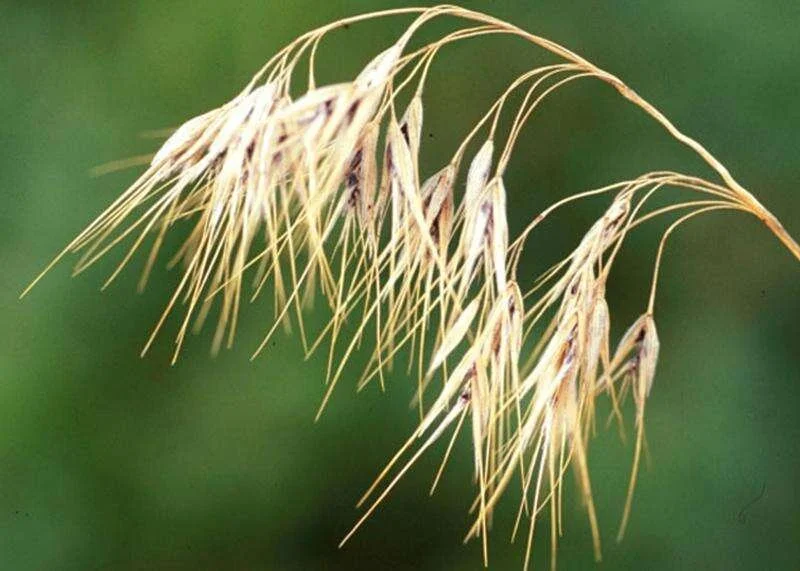Cheatgrass, Bromus tectorum
To some ears, this is a story of evolutionary victory. To some, a story of human failure. But of whom it concerns, this is a story simply of survival, and besides—that whom it concerns is without the ears required to celebrate territory won or to mourn ecosystems lost. At 270 Pope Lane, cheatgrass, Bromus tectorum, has, inarguably, found the best way to survive on the arid landscape. And, as far as cheatgrass is concerned, that’s all that counts. Survival, plain and simple.
To those who witness, interplay, and compete with cheatgrass, it is harder to take such a hands-off stance. Cheatgrass was born in the arid regions of North Africa, southern Europe, and southwestern Asia—a plant that straddled three continents, with the dream to tackle more. As apes learned to stand on their hind legs, walk, and from there to travel, cheatgrass found the perfect vector—and, hitching a ride on these eager explorers, cheatgrass expanded its range. From the greater Mediterranean area, cheatgrass traveled by seeded dirt on ships, on animal furs, on the cuffs of pants onto which it would latch with its barbed seeds—gripping for the life of its DNA, gripping with the intensity of its will to power. Cheatgrass found many homes—in the mountain steppes of Japan, in the sheep hills of New Zealand, along roadsides in Appalachia, amongst glaciers in Greenland. In all these places, cheatgrass prioritized being neighborly, taking what it needed, but not more—for cheatgrass knew this isn’t where it would settle and spread. But when cheatgrass found the American West—dry desert, rolling plains, and arid mesas—it sank its thin roots in and took hold, and the West bent to it. Juniper, sagebrush, blue grama, switchgrass—all these took issue with their new aggressive neighbor, and as they were pushed out, cheatgrass transformed the West. And the plant found a partner in the most powerful player of the region: cheatgrass’ thin stalk and downturned seeds aren’t nutritionally dense enough for the rugged native grazers of the West, but the West was turning itself over to cattle, and cattle and cheatgrass couldn’t get enough of each other. The short lifecycle and quick turnover rate of the plant lent itself well to the unending appetite of these massive ungulates, and cheatgrass grew and was grazed, again and again, doing anything to hitch a ride for its seeds in the migrating stool the cows and bulls dropped. Cattle and cheatgrass, in hushed tones, silently and successfully spread their way across the West, changing the landscape to suit their needs. Cattle liked cheatgrass’ high protein and prolific spread; cheatgrass liked how the cattle dried out riparian areas that are too wet for the plant to take root. Where the two went, the West bent to fit them, and they found other unlikely allies: while native species like juniper and sagebrush are resistant to wildfire, cheatgrass burns hot and fast—and after the ashes have cooled, cheatgrass is the quickest to seed and replenish the ground. As the dry West turned drier under drought, cheatgrass also found an ally; needing very little water, the plant was able to outcompete native species who are accustomed to a baseline of hydration. For sagebrush, for blue grama, four ’o’clock, for Indian ricegrass—cheatgrass saw an opportunity, and gentrified the neighborhood.
At 270 Pope Lane, there are many species, living in somewhat harmony. And then there is cheatgrass, who takes up the most rent, but whose range is pushed to the outskirts, away from walking paths, away from windows. Some call the plant pathetic, the way its weak stem folds over under the weight of its own seeds. But cheatgrass, like the country it has taken foot in, knows how to capitalize on an opportunity. It saw that opportunity in the American West, and with very few attempting to stop it, it kept on going. And so, cheatgrass reigns dominant at 270 Pope Lane. Some may call this a failure; some may call this a success. For the American West, this is the new reality—cheatgrass is here, sinking its thin roots in and gripping tight.
By Apple Lieser

